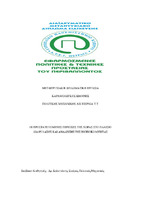| dc.contributor.advisor | Καλογιάννης, Σταύρος | |
| dc.contributor.advisor | Βαρελίδης, Γεώργιος | |
| dc.contributor.author | Καραμολέγκος, Ιωάννης | |
| dc.date.accessioned | 2021-07-13T12:03:04Z | |
| dc.date.available | 2021-07-13T12:03:04Z | |
| dc.date.issued | 2021-06 | |
| dc.identifier.uri | https://polynoe.lib.uniwa.gr/xmlui/handle/11400/766 | |
| dc.identifier.uri | http://dx.doi.org/10.26265/polynoe-617 | |
| dc.description.abstract | Το φυσικό περιβάλλον και το τοπίο της Ελλάδας χαρακτηρίζεται από μεγάλη βιοποικιλότητα και διάφορα κλίματα, λόγω της αλληλεπίδρασης μεταξύ των συστημάτων του καιρού και της χώρας και της σύνθετης τοπογραφίας και της κατανομής της γης και των θαλάσσιων περιοχών. Η Ελλάδα χαρακτηρίζεται από ένα εξαιρετικά κατακερματισμένο, τραχύ τοπίο που φιλοξενεί μεγάλη ποικιλία οικοσυστημάτων και εξαιρετική βιοποικιλότητα. Σχεδόν το 5% της εκτεταμένης ακτογραμμής του αποτελείται από οικολογικά ευαίσθητους υγρότοπους. Η Ελλάδα είναι ενσωματωμένη στη βιογεωγραφική περιοχή της Μεσογείου, με οικοσυστήματα που κυμαίνονται από ημι-έρημο έως ορεινά δάση με κρύο κλίμα όπου θα βρει κανείς σημύδα, πεύκο (Pinus sylvestris) και έλατο. Ποτάμια, εκβολές ποταμών, δέλτα, λιμνοθάλασσες, λίμνες, παράκτιοι θαλάσσιοι σχηματισμοί και υγρότοποι καλύπτουν μια σχετικά μεγάλη έκταση (210.000 εκτάρια) και τα δάση καλύπτουν σχεδόν το 30% του εδάφους της χώρας. Ένα σημαντικό χαρακτηριστικό του τοπίου της Ελλάδας είναι μια εκτεταμένη ακτογραμμή περίπου 15.000 χιλιομέτρων και. 3.000
νησιά, που αντιπροσωπεύουν το 20% της έκτασης. Η ελληνική χλωρίδα είναι από τις πλουσιότερες στην Ευρώπη με
περισσότερα από 5.500 είδη φυτών (εκ των οποίων ένας μεγάλος αριθμός ενδημικών ειδών). Ανάμεσα σε 900 ενδημικά και σπάνια αγγειακά φυτά υπάρχουν είδη όπως το δίκταμο, το χαμομήλι, τον κρόκο, την κεφαλληνιακή ελάτη, τον κρητικό έβενο κ.λπ.
Τα ενδημικά φυτικά γένη περιλαμβάνουν τα Jankaea, Hymenonema, Petromarula. Υπάρχουν πολλές δημοσιεύσεις για το θέμα.
Η Ελλάδα είναι μέρος του επίκεντρου της βιοποικιλότητας της λεκάνης της Μεσογείου. Η Ελλάδα έχει σημαντικές οικολογικές περιοχές για ενδημικά είδη που περιλαμβάνουν τα Μεσογειακά Δάση της Κρήτης και τα Μικτά Δάση της Οροσειράς της Πίνδου. Σημαντικές οικολογικές περιοχές γλυκού νερού περιλαμβάνουν τις λεκάνες του Ιονίου και τις λεκάνες της Νοτιοανατολικής Αδριατικής. | el |
| dc.format.extent | 111 | el |
| dc.language.iso | el | el |
| dc.publisher | Πανεπιστήμιο Δυτικής Αττικής | el |
| dc.publisher | Ευρωπαϊκό Πανεπιστήμιο Κύπρου | el |
| dc.rights | Αναφορά Δημιουργού - Μη Εμπορική Χρήση - Παρόμοια Διανομή 4.0 Διεθνές | * |
| dc.subject | Περιβάλλον | el |
| dc.subject | Περιβαλλοντικές μελέτες | el |
| dc.subject | Βιοποικιλότητα | el |
| dc.subject | Θαλάσσια πάρκα | el |
| dc.subject | Αλιεία | el |
| dc.subject | Γυάρος | el |
| dc.subject | Τουρισμός | el |
| dc.subject | Νότιο Αιγαίο | el |
| dc.subject | Θαλάσσιος χωροταξικός σχεδιασμός | el |
| dc.subject | Περιβαλλοντική νομοθεσία | el |
| dc.title | Οι προστατευόμενες περιοχές της χώρας στο πλαίσιο διαφύλαξης και ανάδειξης της βιοποικιλότητας | el |
| dc.title.alternative | The protected areas of the country in the context of conservation and enhancement of biodiversity | el |
| dc.type | Μεταπτυχιακή διπλωματική εργασία | el |
| dc.contributor.committee | Alexakis, Dimitrios | |
| dc.contributor.committee | Σινιόρος, Παναγιώτης | |
| dc.contributor.faculty | Σχολή Μηχανικών | el |
| dc.contributor.department | Τμήμα Πολιτικών Μηχανικών | el |
| dc.contributor.master | Εφαρμοσμένες Πολιτικές και Τεχνικές Προστασίας Περιβάλλοντος | el |
| dc.description.abstracttranslated | Τhe natural environment and landscape of Greece is characterized by a great biodiversity and various climates, due to the interaction between the weather systems and the country's complex topography and topography distribution of land and marine areas. Greece is characterised by a highly fragmented, rugged landscape that hosts a wide variety of ecosystems and exceptional biodiversity. Almost 5% of the extensive of its coastline consists of ecologically sensitive wetlands. Greece is embedded in the Mediterranean biogeographic region, with ecosystems ranging from semi-desert to cold-climate mountain forests where one will find birch, pine (Pinus sylvestris) and fir. Rivers, estuaries, deltas, lagoons, lakes, coastal marine formations and wetlands cover
a relatively large area (210 000 hectares) and forests cover almost the entire area. 30% of the country's territory. An important feature of the landscape of the Greece has an extensive coastline of about 15,000 km and 3,000 km of coastline, islands, which account for 20% of the land area. The Greek flora is among the richest in Europe with more than 5,500 species of plants (including a large number of endemic species) and more than 5,500 species of plants. species). Among 900 endemic and rare vascular plants there are species such as dittany, chamomile, saffron, Cephalonian fir, Cretan ebony, etc. The endemic plant genera include Jankaea, Hymenonema, Petromarula. There are many publications on the subject. Greece is part of the biodiversity epicentre of the basin. Mediterranean basin. Greece has important ecological areas for endemic species that include the Mediterranean Forests of Crete and the Mixed Forests of the Ore Mountains of the Pindos Mountains. Important freshwater ecological areas include Ionian basins and the basins of the south-eastern Adriatic. | el |

